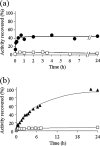Mechanistic studies of the inactivation of TEM-1 and P99 by NXL104, a novel non-beta-lactam beta-lactamase inhibitor
- PMID: 20921316
- PMCID: PMC2981269
- DOI: 10.1128/AAC.00568-10
Mechanistic studies of the inactivation of TEM-1 and P99 by NXL104, a novel non-beta-lactam beta-lactamase inhibitor
Abstract
NXL104 is a potent inhibitor of class A and C serine β-lactamases, including KPC carbapenemases. Native and NXL104-inhibited TEM-1 and P99 β-lactamases analyzed by liquid chromatography-electrospray ionization-time of flight mass spectrometry revealed that the inactivated enzymes formed a covalent adduct with NXL104. The principal inhibitory characteristics of NXL104 against TEM-1 and P99 β-lactamases were determined, including partition ratios, dissociation constants (K), rate constants for deactivation (k(2)), and reactivation rates. NXL104 is a potent inhibitor of TEM-1 and P99, characterized by high carbamylation efficiencies (k(2)/K of 3.7 × 10(5) M(-1) s(-1) for TEM-1 and 1 × 10(4) M(-1) s(-1) for P99) and slow decarbamylation. Complete loss of β-lactamase activity was obtained at a 1/1 enzyme/NXL104 ratio, with a k(3) value (rate constant for formation of product and free enzyme) close to zero for TEM-1 and P99. Fifty percent inhibitory concentrations (IC(50)s) were evaluated on selected β-lactamases, and NXL104 was shown to be a very potent inhibitor of class A and C β-lactamases. IC(50)s obtained with NXL104 (from 3 nM to 170 nM) were globally comparable on the β-lactamases CTX-M-15 and SHV-4 with those obtained with the comparators (clavulanate, tazobactam, and sulbactam) but were far lower on TEM-1, KPC-2, P99, and AmpC than those of the comparators. In-depth studies on TEM-1 and P99 demonstrated that NXL104 had a comparable or better affinity and inactivation rate than clavulanate and tazobactam and in all cases an improved stability of the covalent enzyme/inhibitor complex.
Figures





Similar articles
-
In vitro activity of the {beta}-lactamase inhibitor NXL104 against KPC-2 carbapenemase and Enterobacteriaceae expressing KPC carbapenemases.J Antimicrob Chemother. 2009 Aug;64(2):326-9. doi: 10.1093/jac/dkp197. Epub 2009 Jun 2. J Antimicrob Chemother. 2009. PMID: 19493866 Free PMC article.
-
NXL104 irreversibly inhibits the β-lactamase from Mycobacterium tuberculosis.Biochemistry. 2012 Jun 5;51(22):4551-7. doi: 10.1021/bi300508r. Epub 2012 May 22. Biochemistry. 2012. PMID: 22587688 Free PMC article.
-
Reversibility of Covalent, Broad-Spectrum Serine β-Lactamase Inhibition by the Diazabicyclooctenone ETX2514.ACS Infect Dis. 2017 Nov 10;3(11):833-844. doi: 10.1021/acsinfecdis.7b00113. Epub 2017 Aug 28. ACS Infect Dis. 2017. PMID: 28835096
-
Imipenem-Relebactam and Meropenem-Vaborbactam: Two Novel Carbapenem-β-Lactamase Inhibitor Combinations.Drugs. 2018 Jan;78(1):65-98. doi: 10.1007/s40265-017-0851-9. Drugs. 2018. PMID: 29230684 Review.
-
Combination beta-lactam and beta-lactamase-inhibitor products: antimicrobial activity and efficiency of enzyme inhibition.Am J Health Syst Pharm. 1995 Mar 15;52(6 Suppl 2):S15-22. doi: 10.1093/ajhp/52.6_Suppl_2.S15. Am J Health Syst Pharm. 1995. PMID: 7606585 Review.
Cited by
-
Comparative in vitro and in vivo efficacies of human simulated doses of ceftazidime and ceftazidime-avibactam against Pseudomonas aeruginosa.Antimicrob Agents Chemother. 2012 Dec;56(12):6137-46. doi: 10.1128/AAC.00851-12. Epub 2012 Sep 17. Antimicrob Agents Chemother. 2012. PMID: 22985878 Free PMC article.
-
Broad-Spectrum Inhibitors against Class A, B, and C Type β-Lactamases to Block the Hydrolysis against Antibiotics: Kinetics and Structural Characterization.Microbiol Spectr. 2022 Oct 26;10(5):e0045022. doi: 10.1128/spectrum.00450-22. Epub 2022 Sep 7. Microbiol Spectr. 2022. PMID: 36069578 Free PMC article.
-
Enantioselective Synthesis and Profiling of Two Novel Diazabicyclooctanone β-Lactamase Inhibitors.ACS Med Chem Lett. 2014 Aug 12;5(10):1143-7. doi: 10.1021/ml500284k. eCollection 2014 Oct 9. ACS Med Chem Lett. 2014. PMID: 25313328 Free PMC article.
-
Characterization of a Carbapenem-Hydrolyzing Enzyme, PoxB, in Pseudomonas aeruginosa PAO1.Antimicrob Agents Chemother. 2015 Nov 30;60(2):936-45. doi: 10.1128/AAC.01807-15. Print 2016 Feb. Antimicrob Agents Chemother. 2015. PMID: 26621621 Free PMC article.
-
Ceftazidime-avibactam: a novel cephalosporin/β-lactamase inhibitor combination.Drugs. 2013 Feb;73(2):159-77. doi: 10.1007/s40265-013-0013-7. Drugs. 2013. PMID: 23371303 Review.
References
-
- Bassetti, M., E. Righi, and C. Viscoli. 2008. Novel beta-lactam antibiotics and inhibitor combinations. Expert Opin. Invest. Drugs 17:285-296. - PubMed
-
- Bonnefoy, A., C. Dupuis-Hamelin, V. Steier, C. Delachaume, C. Seys, T. Stachyra, M. Fairley, M. Guitton, and M. Lampilas. 2004. In vitro activity of AVE1330A, an innovative broad-spectrum non-beta-lactam beta-lactamase inhibitor. J. Antimicrob. Chemother. 54:410-417. - PubMed
-
- Bossard, M. J., T. A. Tomaszek, M. A. Levy, C. F. James, M. J. Huddleston, J. Briand, S. Thompson, S. Halpert, D. F. Veber, S. A. Carr, T. D. Meek, and D. G. Tew. 1999. Mechanism of inhibition of cathepsin K by potent, selective 1,5-diacylcarbohydrazides: a new class of mechanism-based inhibitors of thiol proteases. Biochemistry 38:15893-15902. - PubMed
MeSH terms
Substances
LinkOut - more resources
Full Text Sources
Other Literature Sources
Chemical Information
Miscellaneous

